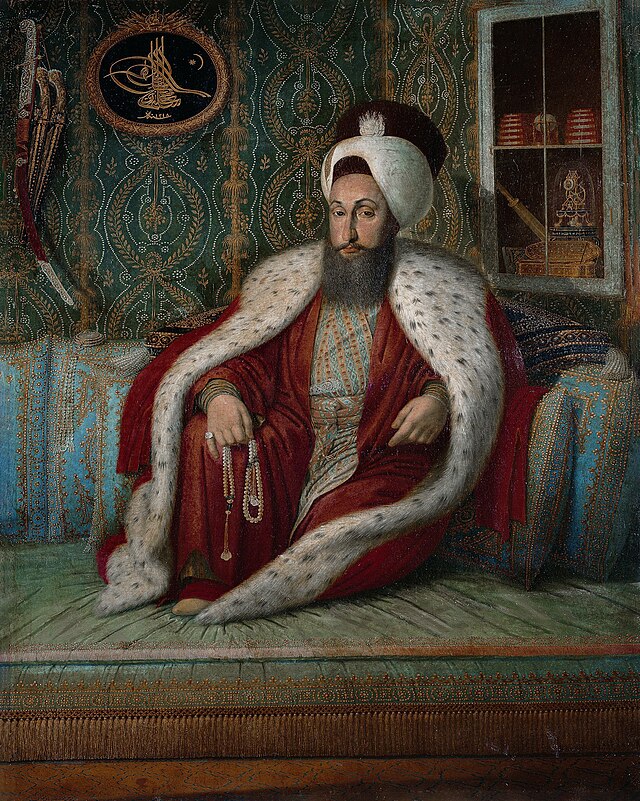Top Qs
Timeline
Chat
Perspective
Mihrişah Sultan (mother of Selim III)
Valide Sultan of the Ottoman Empire from 1789 to 1805 From Wikipedia, the free encyclopedia
Remove ads
Mihrişah Sultan (Ottoman Turkish: مهرشاہ سلطان; c. 1745 – 16 October 1805), was a consort of Sultan Mustafa III, and the mother of Selim III of the Ottoman Empire, and his Valide sultan for 16 years from 1789 until her death in 1805.
Remove ads
Early life
Of ethnic Georgian origin,[2][3] Mihrişah was born in 1745 in Georgia, but there were also rumors that she was in part Genoese.[4][5] She was considered beautiful,[6] and was called "the Georgian Beauty" (Turkish: Gürcü güzeli).[7][8]
As imperial consort
Summarize
Perspective
Mihrişah entered in Mustafa III's harem via the Black Sea slave trade circa 1757 and became one of his consorts and then the BaşKadin (first consort).[9] On 17 March 1759,[10] she gave birth to her first child, a daughter, Hibetullah Sultan.[11][12][13] For the previous thirty years no child had been born in the imperial family, hence, Hibetullah's birth was celebrated in the whole of Istanbul.[10]
On 24 December 1761, she gave birth to her second child, a son, Şehzade Selim (future Selim III). His birth was accompanied by celebrations that lasted a week.[14][15] On 9 January 1770, she gave birth to her third child, a daughter, Fatma Sultan, who died at the age of two on 26 May 1772.[12][16] Among her servants was Dilhayat Kalfa, hostess of Ahmed III's harem and tutoress of Selim III, known to be one of the greatest Turkish composeresses of the early modern period.[citation needed]
She was widowed in 1774, after which she settled in the Old Palace. An archival document from the Topkapi Palace shows that Mustafa III borrowed money from her and that, due to his death, the debt was not repaid.[17][18]
Mihrişah and her son Selim were both members of the Mevlevi Order, which practiced Sufi whirling.
Remove ads
As Valide Sultan
Summarize
Perspective
Selim's accession and political influence

During the reign of Sultan Abdul Hamid I, which lasted for fifteen years, Şehzade Selim remained closed in the Topkapı Palace, and the Mihrişah was sent to live in the Old Palace.[clarification needed] Upon Abdul Hamid's death in 1789, Selim ascended the throne after which Mihrişah became the Valide Sultan.
She occasionally approached her son to beg a favour or an act of mercy.[17] When he launched his Nizam-I Cedid (New Order), both Mihrişah and her Kethüda, by then Yusuf Agha, were his strong supporters. To encourage the reforms so dear to her son's heart, Mihrişah built a mosque for the Humbaracıhane (barracks of the bombardiers) at Hasköy on the Asiatic shore, and founded a school of medicine at Üsküdar.[19]
Yusuf Agha was her second kethüda, who had replaced her first kethüda Mahmud Agha, when he died during tenure of his office.[20] He was capable, and an intimate of Selim. He was persuaded and finally killed by the machinations of Kabakçı Mustafa in the uprising against Selim in 1808, after which his tax farm was given to Sultan Mustafa IV's mother, Sineperver Sultan.[21]
Patron of architecture

Mihrişah was very active in the 1790s as a patron of architecture, especially schools and mosques.
She founded the Humbarahane Barracks, in 1792, which were considered the first modern example of large-scale military buildings.[22]
The Mihrişah Sultan Complex, which Mihrisah founded in 1792 and which was completed in 1796, is in the neighbourhood of Eyüp in Istanbul. It includes her mausoleum and an imaret (soup kitchen),[23][24] today the last still-functioning Ottoman imaret.[25]
In 1793, Mihrişah founded Halıcıoğlu Mosque.[17]
Mihrişah was responsible for the building of the Vâlide Dam on the eastern branch of Arabacı Mandrai in Istanbul, to provide additional water supply to the Büyük Bent.[26]
Mihrişah also built a number of fountains:
- a fountain in Üsküdar İhsaniye in memory of her daughter Hibetullah Sultan, in 1791[26]
- a fountain in memory of her daughter Fatma Sultan, in 1792[27]
- repairs on the Silahtar Yusuf Pasha Fountain in Kağıthane, in 1794[17]
- a fountain between Eminönü and Balıkpazarı in honor of Çaşnigir Zeynep (later called Mihrişah Vâlide Fountain), in 1796[26]
- two fountains on either side of the sebil built for her complex Eyüp, in 1796[26]
- a fountain in Fındıklı Mollabayırı, in 1797[26]
- a fountain in Kılıçali District in Beşiktaş, in 1797[26]
- a fountain in memory of her daughter Fatma Sultan (later called Mihrişah Valide Sultan Fountain) in Yeniköy, Istanbul, in 1805[26]
Fountains built by Mihrişah met the water needs of people in the Beyoğlu, Galata and Boğaziçi neighbourhoods.[28]
Remove ads
Death

Mihrişah Sultan died on 16 October 1805 of unknown causes. She was buried in her charitable complex located at Eyüp, Istanbul.[29][18][30]
Issue
Together with Mustafa III, Mihrişah had a son and two daughters:
- Hibetullah Sultan (17 March 1759 – 7 June 1762, buried in Mustafa III Mausoleum, Laleli Mosque, Istanbul),[31] called also Heybetullah or Heyyibetullah, betrothed on 2 June 1759 to Mahir Hamza Pasha but died before the marriage;
- Selim III (Topkapı Palace, 24 December 1761 – 28 July 1808, buried in Mustafa III Mausoleum), 28th Sultan of the Ottoman Empire.
- Fatma Sultan (9 January 1770 – 26 May 1772, buried in Mustafa III Mausoleum, Laleli Mosque, Istanbul).
Remove ads
In popular culture
- In 1989 Swiss-American drama film The Favorite, Mihrişah is portrayed by French actress Andréa Parisy.[32]
- In 2012 Turkish miniseries Esir Sultan, Mihrişah is portrayed by Turkish actress Ipek Tenolcay.[33]
See also
References
Sources
External links
Wikiwand - on
Seamless Wikipedia browsing. On steroids.
Remove ads